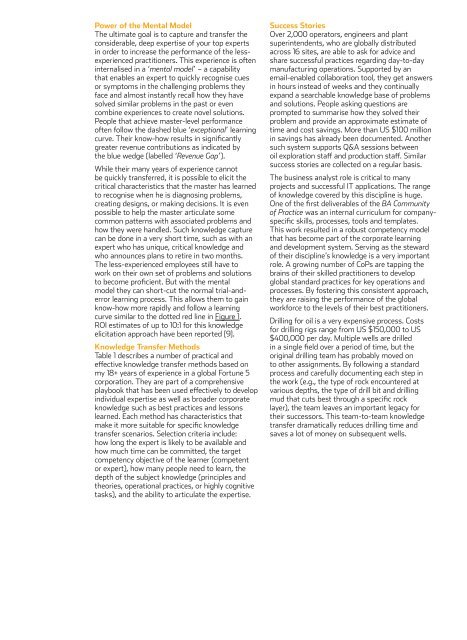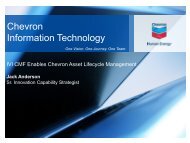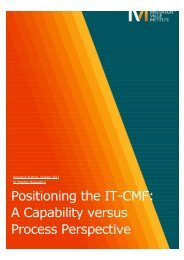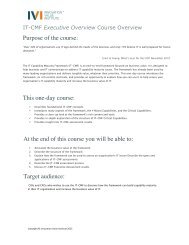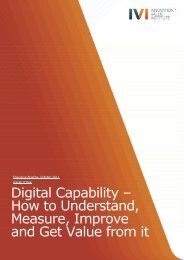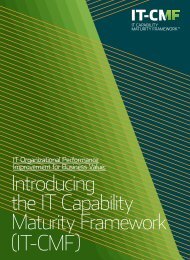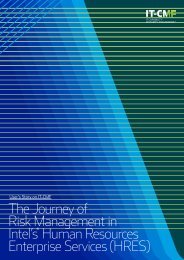IVI - Innovation Value Institute - National University of Ireland ...
IVI - Innovation Value Institute - National University of Ireland ...
IVI - Innovation Value Institute - National University of Ireland ...
You also want an ePaper? Increase the reach of your titles
YUMPU automatically turns print PDFs into web optimized ePapers that Google loves.
Power <strong>of</strong> the Mental Model<br />
The ultimate goal is to capture and transfer the<br />
considerable, deep expertise <strong>of</strong> your top experts<br />
in order to increase the performance <strong>of</strong> the lessexperienced<br />
practitioners. This experience is <strong>of</strong>ten<br />
internalised in a ‘mental model’ – a capability<br />
that enables an expert to quickly recognise cues<br />
or symptoms in the challenging problems they<br />
face and almost instantly recall how they have<br />
solved similar problems in the past or even<br />
combine experiences to create novel solutions.<br />
People that achieve master-level performance<br />
<strong>of</strong>ten follow the dashed blue ‘exceptional’ learning<br />
curve. Their know-how results in significantly<br />
greater revenue contributions as indicated by<br />
the blue wedge (labelled ‘Revenue Gap’).<br />
While their many years <strong>of</strong> experience cannot<br />
be quickly transferred, it is possible to elicit the<br />
critical characteristics that the master has learned<br />
to recognise when he is diagnosing problems,<br />
creating designs, or making decisions. It is even<br />
possible to help the master articulate some<br />
common patterns with associated problems and<br />
how they were handled. Such knowledge capture<br />
can be done in a very short time, such as with an<br />
expert who has unique, critical knowledge and<br />
who announces plans to retire in two months.<br />
The less-experienced employees still have to<br />
work on their own set <strong>of</strong> problems and solutions<br />
to become pr<strong>of</strong>icient. But with the mental<br />
model they can short-cut the normal trial-anderror<br />
learning process. This allows them to gain<br />
know-how more rapidly and follow a learning<br />
curve similar to the dotted red line in Figure 1.<br />
ROI estimates <strong>of</strong> up to 10:1 for this knowledge<br />
elicitation approach have been reported [9].<br />
Knowledge Transfer Methods<br />
Table 1 describes a number <strong>of</strong> practical and<br />
effective knowledge transfer methods based on<br />
my 18+ years <strong>of</strong> experience in a global Fortune 5<br />
corporation. They are part <strong>of</strong> a comprehensive<br />
playbook that has been used effectively to develop<br />
individual expertise as well as broader corporate<br />
knowledge such as best practices and lessons<br />
learned. Each method has characteristics that<br />
make it more suitable for specific knowledge<br />
transfer scenarios. Selection criteria include:<br />
how long the expert is likely to be available and<br />
how much time can be committed, the target<br />
competency objective <strong>of</strong> the learner (competent<br />
or expert), how many people need to learn, the<br />
depth <strong>of</strong> the subject knowledge (principles and<br />
theories, operational practices, or highly cognitive<br />
tasks), and the ability to articulate the expertise.<br />
Success Stories<br />
Over 2,000 operators, engineers and plant<br />
superintendents, who are globally distributed<br />
across 16 sites, are able to ask for advice and<br />
share successful practices regarding day-to-day<br />
manufacturing operations. Supported by an<br />
email-enabled collaboration tool, they get answers<br />
in hours instead <strong>of</strong> weeks and they continually<br />
expand a searchable knowledge base <strong>of</strong> problems<br />
and solutions. People asking questions are<br />
prompted to summarise how they solved their<br />
problem and provide an approximate estimate <strong>of</strong><br />
time and cost savings. More than US $100 million<br />
in savings has already been documented. Another<br />
such system supports Q&A sessions between<br />
oil exploration staff and production staff. Similar<br />
success stories are collected on a regular basis.<br />
The business analyst role is critical to many<br />
projects and successful IT applications. The range<br />
<strong>of</strong> knowledge covered by this discipline is huge.<br />
One <strong>of</strong> the first deliverables <strong>of</strong> the BA Community<br />
<strong>of</strong> Practice was an internal curriculum for companyspecific<br />
skills, processes, tools and templates.<br />
This work resulted in a robust competency model<br />
that has become part <strong>of</strong> the corporate learning<br />
and development system. Serving as the steward<br />
<strong>of</strong> their discipline’s knowledge is a very important<br />
role. A growing number <strong>of</strong> CoPs are tapping the<br />
brains <strong>of</strong> their skilled practitioners to develop<br />
global standard practices for key operations and<br />
processes. By fostering this consistent approach,<br />
they are raising the performance <strong>of</strong> the global<br />
workforce to the levels <strong>of</strong> their best practitioners.<br />
Drilling for oil is a very expensive process. Costs<br />
for drilling rigs range from US $150,000 to US<br />
$400,000 per day. Multiple wells are drilled<br />
in a single field over a period <strong>of</strong> time, but the<br />
original drilling team has probably moved on<br />
to other assignments. By following a standard<br />
process and carefully documenting each step in<br />
the work (e.g., the type <strong>of</strong> rock encountered at<br />
various depths, the type <strong>of</strong> drill bit and drilling<br />
mud that cuts best through a specific rock<br />
layer), the team leaves an important legacy for<br />
their successors. This team-to-team knowledge<br />
transfer dramatically reduces drilling time and<br />
saves a lot <strong>of</strong> money on subsequent wells.<br />
Table 1<br />
Knowledge<br />
Transfer Playbook<br />
04/05<br />
Knowledge<br />
Transfer Method Description<br />
Knowledge Handover<br />
Checklist<br />
Used by manager and incumbent to identify important information<br />
the successor needs to know in order to get up to speed. Topics<br />
include: team’s business context, job roles and responsibilities,<br />
work processes or projects, information sources, key contracts,<br />
and how performance will be assessed. These topics form<br />
the core for many other knowledge transfer methods.<br />
Master Class A learner presents a challenging problem to the expert in a group<br />
setting. Other participants observe and ask questions as the SME<br />
discusses the learner’s situation. The SME provides strategies,<br />
theories, techniques, best practices, common errors, and stories<br />
related to the problem based on personal experience.<br />
Q&A A social networking process that enables a person struggling<br />
with a problem to ask questions and quickly receive answers<br />
from a group <strong>of</strong> practitioners in a discipline or domain. The<br />
process is usually enabled by collaboration tools or email.<br />
Conversation with<br />
the Expert<br />
Colleagues submit questions for an expert which are to be answered<br />
in a meeting or teleconference. During the session, follow-up<br />
questions are possible. The session may be recorded, transcribed<br />
and organised for easy retrieval <strong>of</strong> information nuggets.<br />
Community <strong>of</strong> Practice A group <strong>of</strong> practitioners in a discipline that connect in order<br />
to seek and share experiences, to develop and adopt practices<br />
or tools, and to provide support for a learning agenda.<br />
Peer Assist Experts share experiences and knowledge in a facilitated<br />
meeting with a person or team that is looking for<br />
advice on a challenging problem or project.<br />
Job Shadowing Opportunities for a learner to observe the SME interacting with others or<br />
doing more complex work. Includes setup and debriefing discussions.<br />
Technical Monitoring A structured approach that helps an SME to break work into<br />
teachable moments, with assessment in order to demonstrate<br />
measurable learning. The learner increases their ability to do more<br />
complex work while gaining an insight into the SME’s thinking.<br />
Guided Experience Carefully selected projects or work assignments that fill gaps in<br />
experience or broaden and deepen targeted skills. ‘Guided’ involves<br />
active SME observation and feedback as the work is performed.<br />
Knowledge Coaching Combines mentoring, shadowing and observation to identify the<br />
learner’s competency gaps and guide their development via timely<br />
performance feedback. The SME enables the learner to work on<br />
projects that are above their current skill level in order to accelerate<br />
learning while cost-effectively ensuring that the project is successful.<br />
Team-to-Team Transfer Some complex, structured projects have many unknowns at<br />
the outset. If a team is able to capture learning in an accessible<br />
repository during the project, this knowledge can be reused by<br />
the team for a subsequent project or it can be handed <strong>of</strong>f to<br />
another team in order to significantly accelerate their work.<br />
Knowledge Elicitation An interview-based approach with SME(s) to articulate big<br />
picture, mental models and detailed ‘how to’ and ‘when to’<br />
guidance. Elicitation can be with a single expert or a group.


